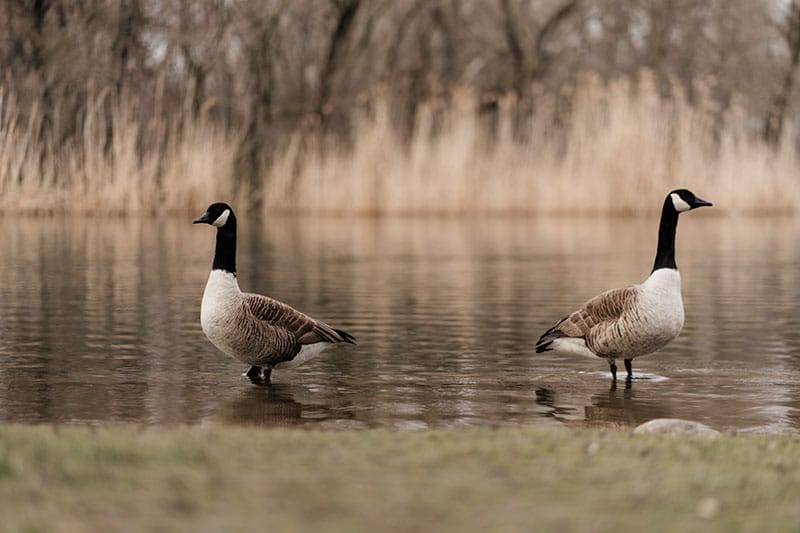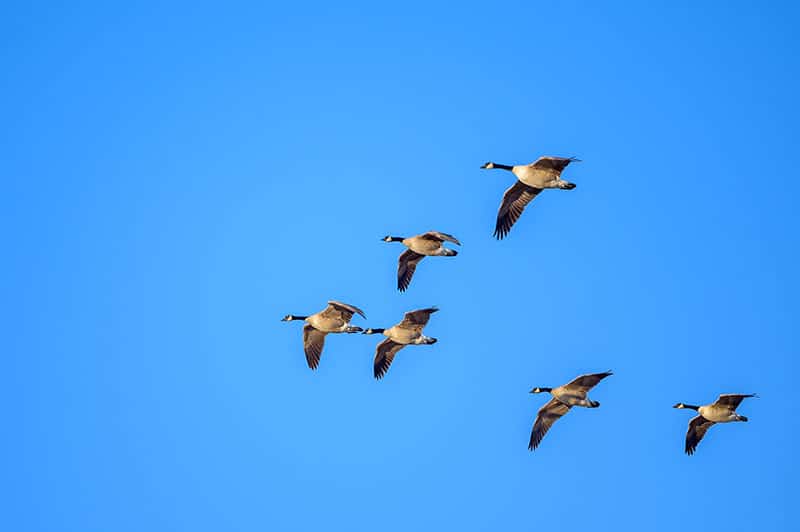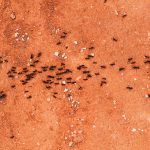7 Canada Geese Facts You’ll Want to Know

However, there are also a few problems Canadian geese can cause for homeowners, as they can cause damage while acquiring their nesting materials or leave droppings behind. Their “V” formation may be beautiful to behold while they’re soaring above you in the air, but they may also spread and carry viruses, bacteria, and parasites.
GreenLeaf Pest Control is here to promote good public health and environmental stewardship by preventing Canada Geese and other birds and pests from invading your home. Don’t hesitate to call us if they fly too close to your home and cause problems!
GreenLeaf Pest Control wants to celebrate this majestic bird by sharing some facts you may not have known before.
1. Weren’t Always Omnipresent
You could be forgiven for believing the Canada goose was always omnipresent since they’re so common across North America. However, in the early part of the 20th century, their numbers were significantly down to hunting and loss of habitat.
Thankfully, regulations and conservation efforts have increased their population, and today there are more than 5 million Canadian Geese across the continent.
2. Loyal for Life
When the Canada goose picks a mate, they keep them for life. These monogamist birds are faithful to the birds they seek out. They practice “assortative mating,” a fancy word for finding partners roughly the same in size.
They begin their hunt for a partner when they are at least two years old. The show of loyalty is nice, but for bird control in Ontario that can decouple these geese from your home, give us a call.
3. Feisty and Aggressive
In the animal world, it’s unwise to get between a mother and their children. When it comes to Canada Geese, they don’t back down when threatened if it thinks their nests or goslings (the word for their children) are in danger.
You’ll see it stretch out its neck and stretch its wings out wide to appear large and intimidating. They’ll hiss and pump their head up and down and even charge at the perceived threat, even if it’s a human being.
If these birds get aggressive anywhere near your home, you’re not going to like it. For the leading pest control in Richmond Hill and all of Southern Ontario, call GreenLeaf Pest Control.
4. Feast in Bunches
Is there anything better than a delightful meal with friends and family? The Canada goose enjoys foraging in groups on land, where they eat plant material like shoots and grass stems, sedges, berries and seeds.
When having a meal over the water, the Canada goose likes to eat aquatic plants and the odd fish, crustacean, or mollusk. When they’re migrating, you can find them on agricultural fields where they eat cultivated fields.
You don’t want them eating anything they happen to find in your backyard, though. For the best pest control company in Toronto and the GTA to deal with Canada geese and other birds, call GreenLeaf Pest Control today.
5. Flying V is Useful
The Canada goose’s “V” shape is familiar to anybody who has seen them fly in formation. The term “flying V” is also familiar to anyone who has seen the 90s Hollywood movie The Mighty Ducks. It’s also a famous Gibson model of guitar. The shape that Canadian geese fly in has inspired people for years. Why do they do it?

When one Canada goose gets tired, it moves to the back of the V for well-earned rest and relaxation. Their movements may seem infinitely graceful and effortless down here, but all that elegant flight is hard work!
6. Birds of a Feather, or Many Feathers
Each Canada goose has between 20,000 and 25,000 feathers, most of which are short and stubby to insulate them from freezing temperatures and icy water. The feathers fulfill an important job and do hard work—to keep them in top shape, they get replaced annually in a process called “moult.”
Feathers on the body and head are gradually moulted over a period of months, while this process occurs on the wings’ flight feathers in the space of one day late in the summer. Afterwards, the goose needs to remain on the ground for weeks at a time, usually between three to five.
It may be controversial when clothing manufacturers use real goose down as insulation for winter jackets, but they do so because it’s some of the best insulation on the planet. For sensitive wildlife control and removal, don’t hesitate to contact GreenLeaf Pest Control.
7. Quick Learners
If you’ve ever seen young children in a swimming class, you know people don’t always take to the water right away. The same is not true for goslings, the name for goose chicks.
Goslings learn to swim within 24 hours of being born. As they age, they assemble with other goslings to form groups called “gang broods.”
The gang broods travel and feed together as their parents supervise and look out for the youngsters. Our bird management services will handle any precocious goslings or geese that get uncomfortably near your home.
The Canada goose is an incredible bird to behold in the air, land, or water. Whether it’s soaring majestically or gliding effortlessly, just to look at them from afar is to admire them. Knowing a few facts about how they live heightens your appreciation, but give us a call if they get a little too close to home.
















You must be logged in to post a comment.